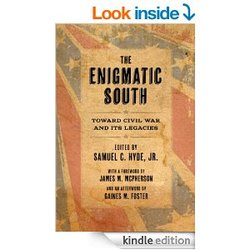
Edited by Samuel C. Hyde, Jr.
Louisiana State University Press, 2014, 244 pp. + 10 pp. Introduction, $42.50
ISBN: 978-0-8071-5694-0
Image courtesy of amazon.com
Throughout the collection of essays portrayed in The Enigmatic South, the outlooks from the contributors present a myriad of interesting topics. From politics to religion along with perspectives on education, the contributors of these essays show the major changes in the south before, during and after the American Civil War. While there have been many studies in the different parts of the effects of war in the south, these essays showcase something new in the world of Civil War academia. While many would consider these essays Lost Cause Historiography without even reading the work, they are not so. While most studies of the south tend to look at the effect of the war during Reconstruction, this collection shows every major aspect of the south throughout the entirety of Civil War studies.
The contributors to these essays are Christopher Childers who writes an essay about States Rights after the controversies and politics of Missouri’s Slavery. Sarah L. Hyde writes about the education developments of the Antebellum south in the Gulf states. Julia Huston Nguyen writes of religion and mainly Clergymen in Louisiana during secession. George C. Rable writes an essay on Clement L. Vallandingham. Paul F. Paskoff writes about the wealthy southerners who fought in the war in an intriguing title called “Rich Man’s War.” John M. Sacher writes of Jefferson Davis and the conscription of Confederates. Richard Follett writes about the career of Pierre Champomier. Samuel C. Hyde, Jr., the editor of the collection, writes about the Bowling Green Plantation and Wilkinson County. Eric H. Walther writes about William Lowndes Yancey and the way he wrote and obscured history. Lastly, Gaines M. Foster writes of William J. Cooper. As the editor, Samuel C. Hyde, Jr., is the Leon Ford Professor of History at Southeastern Louisiana University. He is also the author of several other Civil War works including Pistols and Politics: The Dilemma of Democracy in Louisiana’s Florida Parishes, 1810-1899.
As stated earlier, one of the nice things about this collection is the fact that there are three parts to the work: Antebellum, The Civil War, and Reconstruction. It was a breath of fresh air since most books on the Antebellum south tends to pay more attention to politics than to the other major points of society during that period. While reading Nguyen’s essay about religion and Clergymen during the secession crisis, showed that even though preachers used the pulpit to expose their own political beliefs, they were able to use the pulpit to enable the soldiers to think very much the same as them. One of the preachers in which she mentioned talks about the statement of defenders of their God and their way of life which used religion in order to aid the Confederate cause. Sarah Hyde’s essay on education was particularly interesting when talking about the different types of schooling. From private schools to home schools, they were all determined on the way in which society was placed; if homes were more spread out, than the education system would more likely be home schooled. Paskoff’s essay about the “Rich Man’s War” not only used modern research to prove his point, but used well labelled and easy to read tables to aid in his thesis. While I do not have the time to go over every essay in the collection, I should say that they are all excellent works on the analysis of the south from the Antebellum Period to the Reconstruction Period.
I highly recommend this work to anyone interested in the American Civil War and anyone interested in the evolution of Southern Culture throughout American History. The Enigmatic South is an excellent collection of essays which bring about new scholarship to the study of Southern Culture during the Antebellum period through the Reconstruction. What these contributors have brought about in this collection should aid future historians in the understanding of the south during the Civil War period. It is my hope that these essays will be used to further understanding the people of the south for years to come. I applaud all the contributors of this work and hope that we see more works by them in the coming future.
 RSS Feed
RSS Feed
